
Ultramarathons? I could do that, couldn’t I? I had just discovered the existance of ultramarathons and within a week registered for the 2004 Bear 100 to be run in less than three months. I was eager to test myself in this new-found sport. I believed I could do it, but still had my doubts. I began researching ultramarathons on the Internet, reading various race reports, and studying the Bear 100 course. I discovered that a 50K race, the Midnight Mountain 50K was held on the exact same course in just two weeks so I quickly entered it. It would be a good way to learn about the course and get a taste of this ultrarunning sport. I had run about 600 miles so far this year which I thought was a ton of miles, and felt ready. The last running race I had entered was back in 1977, a 5K.
I needed to prove to myself that I could run really big miles. As I read Wasatch 100 race reports, I kept saying to myself, “I can do that.” In response, I quickly planned another fool-hardy adventure for a 48-hour run. I started at Spanish Fork Canyon, a few miles below Soldiers Summit, and planned to take the Great Western Trail all the way to Provo Canyon. I’m embarrassed to admit that I really believed I could continue all the way to Brighton in those two days. No one told me I couldn’t, so I believed I could. I knew nothing about the concept of tapering before my 50K in a week.
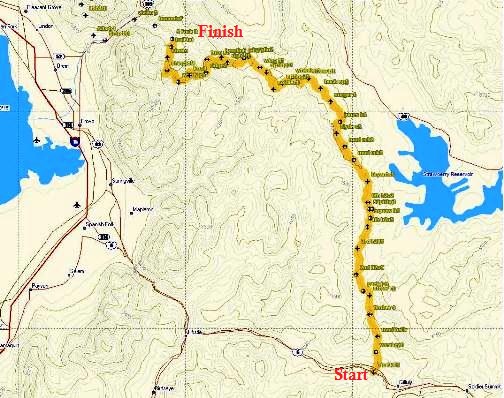
I started on a Thursday afternoon and by evening had climbed up to Strawberry Ridge (the ridge to the west of Strawberry Reservoir) with my much too heavy seventeen-pound pack. (What was I thinking?!) At about the sixteen-mile mark on the ridge, I made a camp for the night and started a campfire for my dinner. Sparks thrown by the fire made a hole in my camelback bladder which I eventually patched. I tried sleeping for a few hours but was literally chased away at 1:00 a.m. by a skunk that wanted my stuff, so I continued on in the early morning. My route joined what years later I learned was the Katcina Mosa 100K course at the Bathtub spring and I would take that route all the way to South Provo Canyon. It was grueling but beautiful to be in the Wasatch back country, where in 1980, I dreamed of exploring. But I totally underestimated the difficulty.
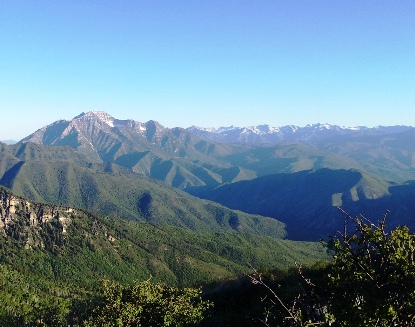
I ate the last of my food at Little Valley, the 40-mile mark. When I saw the 1,500-foot Bozung Hill for the first time, my heart sank knowing that I would have to go up and over that ridge. I was already totally out of gas. I noticed some pink flags along the trail and just couldn’t figure out what they were for. I told myself, “No way could there be a race on this trail! Maybe it could be a mountain bike race course? It surely was not a running race going up or down this steep hill!” Months later I was amazed to learn that I was on the Squaw 50 course. I had discovered ultrarunning just a week earlier and little did I know, I was on an ultramarathon course.
After more than 24 hours, I finally made it to the South Provo Fork road where my wife took me home in great pain. I was very humbled, but I had traveled about 55 miles from Spanish Fork Canyon all the way to South Provo Canyon, climbing about 12,000 feet along the way.
My first ultramarathon – 50K
I recovered fast and just one week later traveled with my family to Preston Idaho, to run my first ultramarathon, Midnight Mountain 50K. This was the first time I had ever seen other trail runners. I felt like an outsider as many of this group of about 45 clearly knew each other and talked excitingly about other races they had run. It seemed like many of this group traveled from race to race together over the summer. (Little did I know that among this group were at least 10 runners who would become my very good friends in the years to come). I observed two types: A group of experienced runners and a group of rookies like me, some who had pretty heavy day packs. I was the only one with trekking poles and I was asked by others how I used them. I had no idea how well I would perform in this 50K (31 miles). I actually believed that perhaps I was very good and would compete well. I had no way of knowing, having never run with an ultrarunner before. I thought I could finish at least in seven and a half hours. I was surprised that the start was so casual. The race packets arrived late so the race started 20 minutes late.

Off we went. For the first monster climb among the scrub oak, I did well and ran in mid-pack. It seemed very unusual to have so many others running with me who also loved running the trails. Yes, I was in the right group. But after three hours, at about mile 14, I fell behind. We had a long downhill section and I was in complete awe how the runners could run downhill with speed. My knees just wouldn’t let me go fast at all. I realized that I was being totally out-classed by those around me. I continued on and never had thoughts of stopping. I saw my goal pace slip away. I was very impressed by how friendly people were. They would stop and ask me if I was OK and I found a good friend in Tony Dearcos who had finished his first Wasatch 100 in 1998.
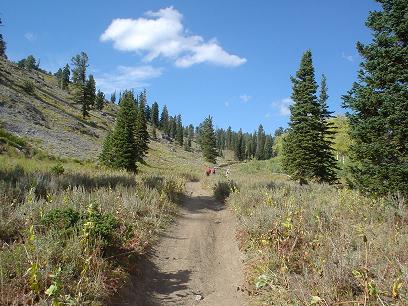
I knew my family would get tired of waiting for me, but I just couldn’t go faster so I enjoyed the forests, ridges and valleys up above Bear Lake. Eventually the finish line came in sight and my little boy shouted, “Finally!” I finished in 9:23, 30th place out of 43 finishers. See the results. I was shocked to see that the winner, Ty Draney, had finished more than four hours before me. But, for the first time I was able to measure myself against the best ultra-long distance runners in the area. I learned that I was back of the pack, but still was part of the group. I was hooked on ultrarunning.
I recovered fast and continued to work hard. The next Saturday I attempted my first double Timpanogos, running to the Summit twice from the trailhead. On my second trip I created quite a stir on the mountain. Many people asked how many times I was doing it. A couple groups yelled out, “Go for 3!” “Go for 3!” One group clapped and cheered. Many would say, “you are great” and “way to go.” I didn’t expect this reaction, but I guess if you pass hikers three times on one hike it does get their attention.
My first 50-miler
Three weeks after my first ultra, I stepped things up again and was in Washington with my family to run White River 50, my first try at a 50-miler. The race ran near Crystal Mountain where I skied often in my youth. At the check-in for this race, I looked around at the athletes and very quickly concluded that I was a pretender. They were all lean and strong. In the past two years I had lost a lot of weight but was still 190 pounds and looked like the heaviest one there. The field included so many elite runners, runners who I had never met or heard about before, Karl Meltzer, Uli Steidl, Hal Koerner, Ian Torrence, Nikki Kimball, Jeff Browning, and others. I felt embarrassed to be there and almost hoped that no one noticed me. But it was fun to be with my family in the beautiful Cascade Mountain Range, not far from Mount Rainier.
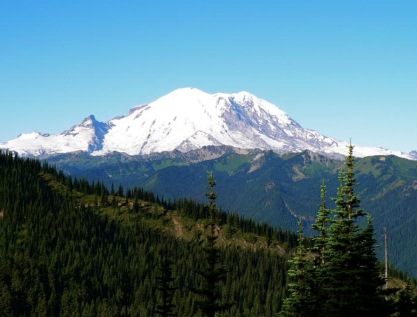
I took the one-hour early start with a few others, including a guy who was running his 50th ultra in 50 states. He was giving others advice about using a run/walk pacing technique. But after the first half mile, I just ran, still with my trekking poles. I was the first one to the first two aid stations. It was then fun to watch the front-runners from the normal start catch up and really go up a hill fast. These elite runners were very nice and said kind words to me as they passed by. Streams of runners started to pass me and I tried to keep up, but at the half-way mark, 25 miles, the clock was at 6:40. I would have a very tough time finishing before the 14-hour cutoff. I saw some runners quit at that point but I continued on. I didn’t look at all like an ultrarunner with my trekking poles and two soft braces on each knee, but I was just trying to finish. I kept a very close eye on the clock and with ten miles to go, I knew I was in last place. My knees were in great pain (probably because I wore those stupid braces) and I pushed the last seven miles as hard as I could. With a quarter mile to go, I threw down the poles and sprinted as fast as I could. I indeed finished in last place (DFL) in 14:00:02, only two seconds over the 14-hour limit. But I was credited with an official finish, I guess because I took the early start. I always love looking back at the finisher list and seeing my name at the bottom. See the results.
I was in great pain at the finish and my son asked me if I still was going to run Bear 100. I didn’t answer, but the thought in my mind was, “no way. I was in so much pain going only half that distance.” I learned many good lessons: Fix a blister when it first gets noticed. Take time at each aid station to eat and drink. Don’t get lazy and walk slowly for long periods of time. Don’t let the cut-offs get too close and add stress. Don’t wear knee braces. With your family at the finish, don’t get them worried when you really are just fine.
My first 100K
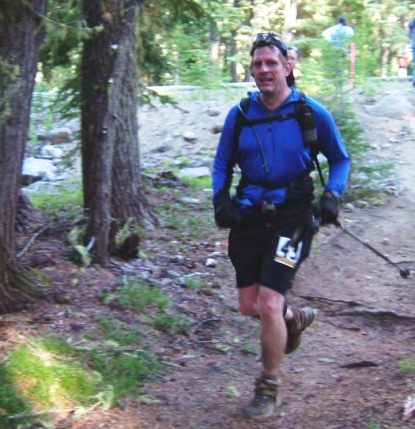
I didn’t stop. Three weeks later I travelled with my son to Oregon and toed the start line of Where’s Waldo 100K. I took the two-hour start with a large group and led the pack after five miles feeling great. The day was beautiful running in the evergreens. It was thrilling to have my son pace me for about 12 miles. But about mile 40, I looked pretty thrashed. The aid station captain was quite concerned and I assured them that I fine and had done this before. But still he sent a guy on a horse to trail me for several miles to make sure I didn’t collapse. At about mile 50, I found myself in last place again and two sweepers were nipping at my heels. My other knee was having some serious problems. When I reached the next aid station, with still another monster climb ahead, I decided to quit, my first DNF. I then hiked another five miles down to our campground. I had covered 54 miles, a new one-day personal record for me.
Witnessing my first 100-miler
One big problem I still had was that I did not have a mentor. I soon discovered that an old friend from my youth, the brother of my best friend, was an elite ultra/adventure runner from Colorado, Todd Holmes. This year he was running what is called the “Grand Slam,” four prestigious 100-milers. As I was licking my wounds for the next couple weeks, we traded emails and I was excited to have someone that I could get advice from.
Todd was running in the last race in the Grand Slam, the Wasatch 100. I decided that I would surprise him and greet him on the course during the night. My knee was still bad, but I hiked up to the Rock Springs aid station (mile 87), surprising the volunteers there who don’t see any spectators in that remote location. I then ran backwards on the course looking for Todd and greeting the front-runners with their pacers. It was a wonderful night and I was thrilled to be on the Wasatch course, witnessing this amazing race first-hand. I reached Pole Line Pass (mile 83) and waited about an hour, watching all the runners come in at from about 2-3:00 a.m.
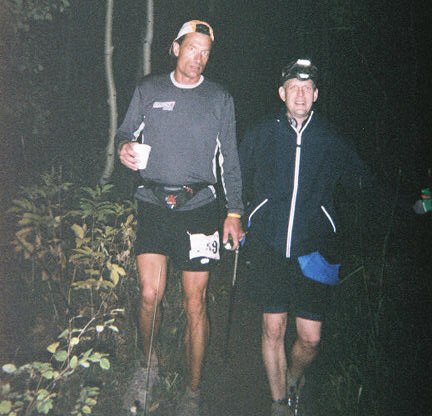
I then started running toward Ant Knolls but very soon ran in to Todd. He was totally amazed to see me. We had not seen each other for about 30 years. What a crazy place and time for a reunion. He introduced me to his pacer, Joe Kulak, who was the current record holder for the Grand Slam. I was in awe as I ran with these two guys. Todd had been at a very low point, but Joe commented later that I really perked him up. I had no problem keeping up as we ran back to Rock Springs and beyond. Todd and I caught up on things for the past 30 years and talking about all our family members. I was like a gushing fan running with the two amazing ultrarunners.

I finally bid good-bye at the top of The Plunge. Later in the afternoon I went to the finish at Midway and watched for a couple hours as the final runners finished their 100 miles. I saw great emotion among the finishers, including pain, tears, hugs, and smiles. I wanted that experience in two weeks at the Bear 100. I received plenty more advice from Todd, the only runner there I knew. (Looking back at the finishers, I was actually surrounded by about 40 of my future good friends).


Really awesome reads all of these. Thanks Davy!
Best part so far. Looks like you worked hard making this transition in your life and learned a lot of lessons the hard way. Very impressive that you didn’t get discouraged. True inspiration to those of us just getting into the sport.
I’ve enjoyed reading these Davy, thanks for the inspiration.